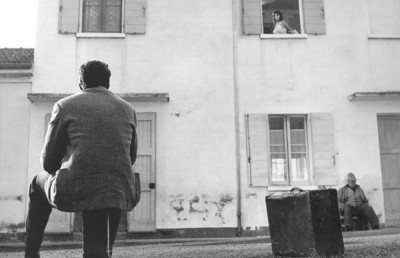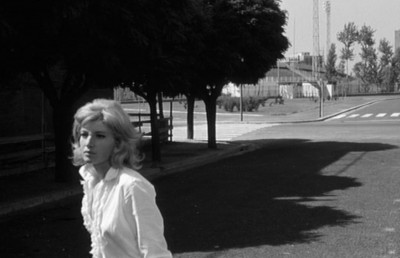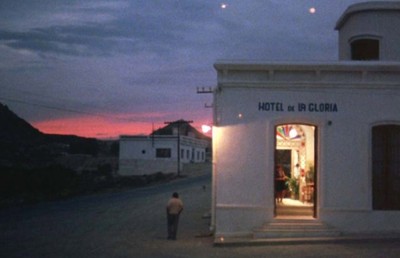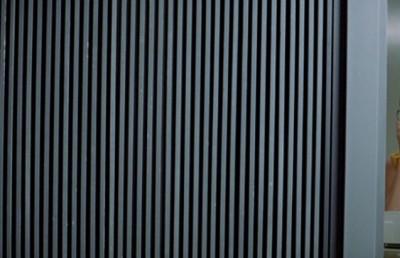Femme Antonionienne
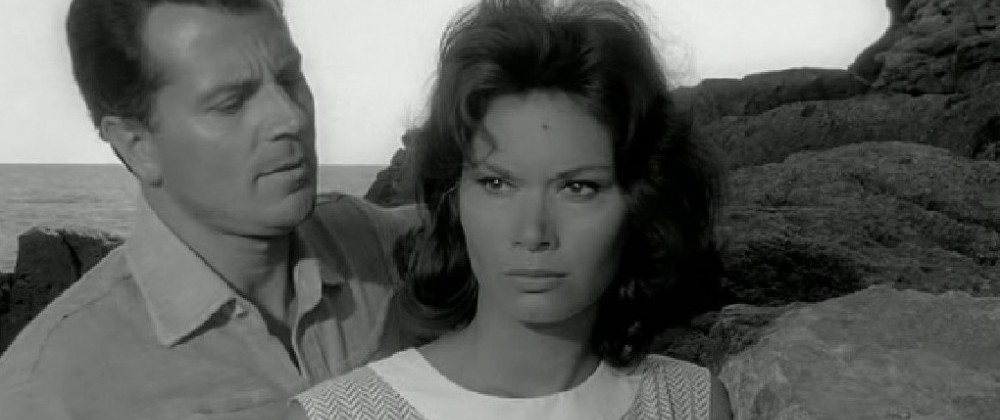
Michelangelo Antonioni is one of the rare filmmakers of the 1950’s and 1960’s who demonstrated a vivid interest and concern for the feminine perspective. He didn’t attempt to show simply his sympathy and respect for the fairer sex, but believed that their emotional and existential quest was of significant interest in his artistic representations. His exceptional ideas and opinions toward his female characters are discernable not only through the scripted dialogue, but in the orchestration of images and the composition of the frame. Taking two films from his prolific filmography as examples in which we can experience Antonioni’s complex reflection of unique women in this way, Il Grido as well as L’Avventura, we can remark that the cineaste utilizes the environment, the décor, and most importantly the mise-en-scène to communicate implicitly his thoughts about his characters. Still, a question remains: What exactly is the director attempting to convey regarding women and, more particularly, regarding their relationships with men? The style and aesthetic coalesce as elements exposing the admiration that Antonioni maintained for these women and their epoch, a notion we could say was quasi-inexistent in the seventh art in Italy at this period of cinema: “These films not only document the difficulties that attend any emotional relationship as most critics have pointed out, but they also offer a specific analysis of the situation of women in contemporary western society of the 1960’s an analysis that present a sustained attack on the patriarchy, and this attack is surprisingly, for its time, sympathetic toward women as women”. [1] Thus, while we can consider Pina (Anna Magnani) in Rosselini’s Rome Open City as an exemplary Neorealist depiction of a strong and free-willed popolona (a woman of the common people) —a character who is nonetheless killed off in the film after only fifty-five minutes— Antonioni, on the other hand, was developing women independently of their men, who in turn demonstrated themselves to be instinctual and impulsive individuals disconnected from themselves and others. These “Antonionienne” women distinguish themselves from their masculine counterparts by their self-empowerment and furthermore their volition to make choices which will verify their emotional and moral preeminence over their male compatriots.
One of the most telling narrative distinctions between the two films is that L’Avventura, as in many of the director’s films, follows characters from the bourgeois class while Il Grido leads the spectator through the life of the working class. Antonioni holds the opinion that the working class employed a more direct method to engage their emotions: “It’s not true that workers have coarser emotions than ours [les bourgeois]: all that’s different is their way of dealing with them, of expressing them[…] They go back to the source of the emotions, live them in their true, immediate substance; in short they go more to the heart of things”. [2] In Il Grido, Irma makes her sentiments and intentions clear to Aldo, unlike her analogous persona Anna, who chooses, after an unsuccessful last attempt at communicating with Sandro, to put an end to their relationship by simply eclipsing herself from his life. By comparing the two scenes of parting, even though quite different from one another on the level of narrative, we can still note an important similarity: the strength of the women to perceive reality for what it is, and to have the determination to make crucial decisions and, likewise, assume the consequences.
First, we can present these two homonymous characters: Irma and Anna. From the very start of both Il Grido and L’Avventura, these women are introduced as the leading ladies of their respective narratives. Beginning with the first take, Irma and Anna walk assuredly toward the moving camera (DVD Timecode 02:30-02:52). In the first minute of Il Grido, Irma marches determinedly into the foreground from the left to the right of the frame, all the while followed by the panoramic movement of the camera. The same blocking can be detected again in the first scene of L’Avventura, where Anna also strides unwaveringly toward Antonioni’s lens. This choice from the filmmaker demonstrates his desire to establish first and foremost from the commencement of the films the vigour and poise held by these women.
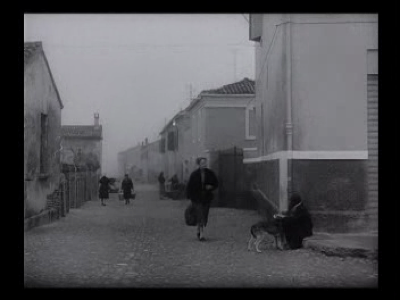
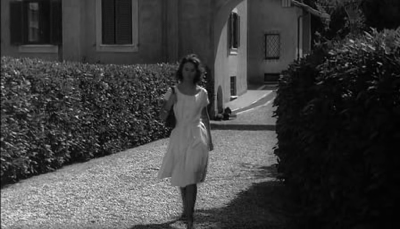
The director puts several elements in place during Irma and Aldo’s breakup (DVD Timecode 09:10-11:55) in order to communicate Irma’s emotional superiority to Aldo. First, Irma’s arguments are those of a woman who has the audacity to live to the height of her sentiments. She tells him clearly that her decision is the right choice to make if she is to be honest with herself, and with him as well. Existentialist thought sees this quality of choice as essential to the evolution of a human being, with Jean-Paul Sartre himself proclaiming in his Existentialism is a Humanism that, “Man simply is. Not that he is simply what he conceives himself to be, but he is what he wills and as he conceives himself after already existing – as he wills to be after that leap towards existence. Man is nothing else but that which he makes of himself. That is the first principle of existentialism. […] Thus, the first effect of existentialism is that it puts every man in possession of himself as he is, and places the entire responsibility for his existence squarely upon his own shoulders.” [3] Sartre’s insistence on the masculine pronoun is subverted by Antonioni’s perspective: for him it is modern women like Anna, Irma, and maybe eventually Claudia, who will have the courage and the will to make a choice capable of changing their lives, and hence seize their existence and ontological freedom. Aldo, unlike Irma, won’t be able to overcome this existential necessity with the same grace and dignity. When Irma turns her back on him his response is immediately violent, grabbing her and (barely) stopping his hand from lashing out. This recourse to violence proves that Aldo is a man who lives according to his values and archaic social convention, proclaiming that a man has to control and posses a woman, whereas Irma is a modern woman who claims her right and makes choices of her own accord in a society that she knows will not permit her to do so. In the first act of the film, just prior to his departure, Aldo tries by every and any means necessary, which he still believes effective, to repossess her: he courts her with old-fashioned tactics, such as attempting to convince her to stay by offering her a gold belt-buckle, and finally, in final effort, strikes her down in the public square. Through Aldo’s volatile reaction, Antonioni suggests that these beliefs are outdated and that the belt buckle, and likewise Aldo’s back hand bargaining, are powerless to change Irma’s mind: “His desperate act seems designed to prey on Irma’s status as the ‘weaker’ sex, with the hope that the public humiliation will put her back in her place, but the act backfires”. [4] The tragedy of Il Grido lies precisely in Aldo’s inability to adapt to the emotional strife left to him in the wake of Irma’s decision. He has neither the strength nor the will to move on with his life. Antonioni portrays Aldo’s fragile emotional state through the forested background of the composition throughout their dispute. Irma touches and even seizes the biggest and most firmly rooted tree behind her while Aldo stands in front of the fragile branch: “Antonioni suggests, I think, in the sturdiness of the tree against which Irma leans something of her own tough resilience, she is a strong woman. Aldo, by contrast, is defined by the pollarded willows, but above all by the Lombardy poplar, soft wood, frail, easily broken”. [5] This use of the weeping willow and fragile poplar to represent Aldo’s weakness and inconsolability, is exemplary of a particularly Antonionian aesthetic.
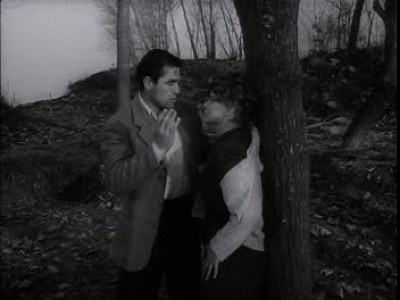
The character of Aldo is in some manner a precursor to Sandro, the male protagonist of L’Avventura. This man will similarly become a victim of a breakup incurred by his own outdated and inadequate preconceptions of how to coexist with women. Whereas Aldo is unable to keep a cool head in front of Irma, Sandro stubbornly disregards Anna’s remarks and frustrations. The absence of communication on Sandro’s part reflects, in a certain way, the superficial social class to which he belongs and which Anna holds in contempt. The last scene in which Anna appears corporeally is a key moment in the film which introduces, more than aptly, Sandro as a character who has lost touch with himself, and moreover with others (DVD Timecode 23:47 – 26:10). In this scene, we can see Anna’s last attempt to express to Sandro the bad path that their relationship has taken. Antonioni orchestrates the movement and the positioning of characters in the composition of the frame to invoke visually the divide in communication between the couple. Antonioni positions Sandro and Anna constantly with their backs to one another, speaking over their shoulders or lost in their own dreamscapes. The dialogue is certainly evocative of Anna’s desire to explain the problem to Sandro, but the images that the filmmaker projects upon the screen remain far more powerful – they become metonymic. Take for example the shots where Anna stands in the foreground against the rocky coast, where one can clearly see Corrado and Giulia bickering in the background (DVD Timecode 25:05 – 25:33). This quasi-caricaturized couple is positioned in this manner in the frame to bring the spectator to compare and observe that the two couples are commensurable in their futility and their superficial existence, drifting along the surface of the emotions. When Sandro walks in the frame to join Anna, Corrado and Guilia disappears behind the rocks. In taking the place of this couple, their union matches Giulia and Corrado’s. It is also amusing to note that Anna says at one point, talking about the couple, before this specific framing: “… aren’t they living as though they were married?” Anna, in comparing her coupling with this futile union suggests that getting married does not ameliorate the intimacy and the closeness of a couple.
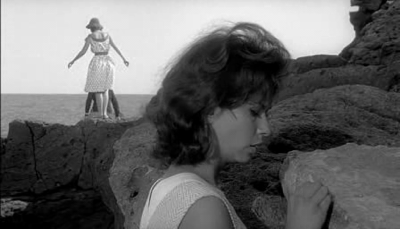
This scene shows equally one of the most recurrent maxims in Antonioni’s body of work, that “Eros is sick”. Sandro sees sex as a kind of escape from his problems. When Anna tells him “I don’t feel you anymore,” Sandro replies that the previous night, in bed, he could tell that she had already become disaffected with him. In his reply, Sandro grabs her aggressively, echoing Aldo’s previous recourse to physical violence. Following Sandro’s last word, Antonioni cuts suddenly to Anna’s incandescent gaze, suggesting that she does not see the pertinence in making an allusion to sex while they are discussing the complete void of communication in their partnership. Even though the circumstances of her disappearance remain nebulous, one can see in this scene that Anna realizes that their romance is going nowhere and finds the strength, like Irma, to take the harsh decision to end her and Sandro’s atrophic relationship.
Time and time again in L’Avventura, Sandro employs sex as an alternative to the problems in his own life, as a balm to put on his psychological wounds. Antonioni sees these sexual impulses as destructive urges: “And whenever something bothers him, man reacts badly, only on erotic impulse, and he is unhappy. The tragedy in L’Avventura stems directly from an erotic impulse of this type –unhappy, miserable, futile”. [6] If we analyze the sequence in which, just after having deliberately spilled an inkwell on a young painter’s drawing, Sandro tries to fill void within him, anchored to his failed career in architecture, by making sexual advances toward Claudia, in spite of having completely ignored her spontaneous moment of eroticism only moments prior (DVD Timecode 1:53:58 – 1:56:58). After his passive-aggressive affront to the painter and his work, Sandro comes back to the room and drifts to the balcony of their room to admire the architecture of the city, all the while wearing an impotent and nostalgic expression on his face. After a moment, he decides to literally shut the window on his source of frustration. In contrast to his distracted and lost appearance in the preceding take, he leaps abruptly upon Claudia and thrusts her down violently on the bed. Claudia understands that he is desperate and seeks to use her as a diversion from his own ennui, and therefore refuses to be used as his momentary distraction. She tells him that she doesn’t recognize him, when he in fact is unrecognizable to himself, and he is merely following his own animalistic sexual impulses. In this scene, Antonioni condemns this unhealthy instinct, and by giving primacy to Claudia’s face and her expressions in the montage throughout the sequence, we can see that the cineaste believes that this woman’s subjectivity retains primacy in this episode of sexual malaise. Through these subdued facial expressions, captured in explicitly in close-ups, Antonioni aligns himself with Claudia’s contempt of Sandro’s inappropriate reaction to treat her as a mere sexual object.
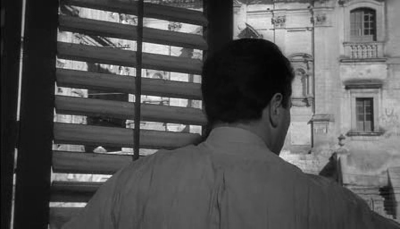
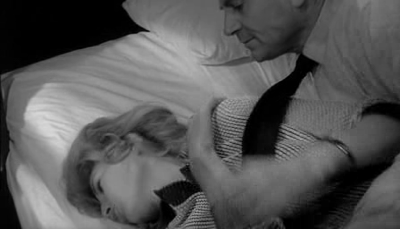
In similar stride, Aldo’s character is also a victim of “sick Eros” through his maladjustment in the face of his own breakup. Throughout the three women who he will encounter on his journey, he will find in all of them a modern women, and therefore a fragment of Irma: “Face à la situation nouvelle créée par le départ d’Irma, Aldo qui paraît si fort, s’effondre parce qu’il est mal préparé à y faire face. En face d’Aldo, toute à sa passion, nous trouvons au contraire des femmes libres qui s’efforcent de prendre en mains leur propre destin, et en premier lieu Irma”. [7] Aldo will attempt, just like Sandro, to fill his inner void with an illicit sexual moment. When Elvia informs him that Irma has just passed by – though he believes that he has begun to forget about her – he falls back into the same melancholy from before, and in his reaction Elvia realizes that she will always be second in Aldo’s heart. In the following scene (DVD Timecode 41:10-43:04), Aldo will try, like Sandro, to satiate his erotic melancholy by permitting himself to succumb to Edera (Elvia’s sister) and her sexual advances. He allows her to kiss him, but will inevitably decide to put her to bed. He then descends down the stairs and collapses into his bed while lamenting and imploring Irma. Antonioni, in a long shot, shows Edera watching and laughing at Aldo from the top of the stairs. The descent from the staircase forecasts his fall from the tower at the end of the film, which in this case suggests not only his sexual but also existential impotency. Even though Edera’s mocking laughter appears cruel, it poignantly depicts the director’s will to show that Aldo’s behaviour is somehow pathetic and indignant. Women are proven to tackle their most complex emotions with dignity (Elvia will take Aldo’s rejection with poise and self-control) while Aldo will not be able to overcome his misery and will try to bury it beneath sexual impulses, which will only serve to deepen this void within.
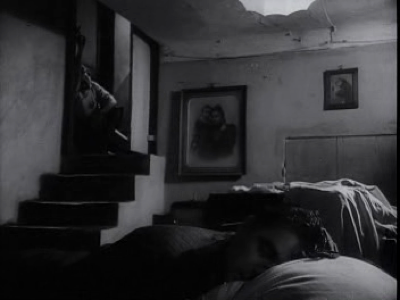
We find an equally important demonstration of the emotional fortitude carried by women in the conclusion of L’Avventura. Throughout the whole last scene, the filmmaker utilizes the mise-en-scène and, more particularly, the composition of the landscape to communicate Sandro and Claudia’s state of mind. This sequence (DVD Timecode 2:19:54 – 2:22:58) begins with a close-up of Claudia’s face, which appears distraught and deeply moved after having found Sandro with another woman, as warm tears swell in her eyes. Hearing the steps of her unfaithful lover behind her, she tries to hold back her tears. Antonioni then cuts to a larger shot in which we can see Claudia’s back and Sandro advancing toward her to finally sit on the bench just in beyond of her. Claudia turns to look at him, but remains standing behind him. We then cut to a close-up of Sandro’s face, also streaked with tears. Claudia has made him realize the pathetic and egocentric person he is: “« Les femmes amènent une provocation à la lucidité qui ont le don de rendre à leur aveuglement l’impétuosité des mâles”. [8] Not only does Antonioni incorporate Claudia’s torso behind Sandro in the frame, situated behind him and to the right to remind the spectator constantly of the presence of a woman/mother figure, but he also positions a tower, equally dominant on the other side of the frame, which undoubtedly bears a phallic symbolism. In other circumstances such a symbol would have visually cemented patriarchal values and, therefore, masculine superiority, but in this context it functions more as a form of irony, suggesting Sandro’s own impotence. [9] We cut again suddenly to Claudia’s hand, which strains to want to move toward Sandro to console him, but eventually resists reaching out to him. The camera then tilts upward, following her hand, finally offering him her compassion. Antonioni underlines the importance of this gesture by introducing music at the moment Claudia’s hand makes contact with his head. The composition of the last shot of the film could not be more indicative of Claudia’s moral and emotional superiority in the face of Sandro’s collapse. The film cuts to a large shot from behind the two characters where we can see the man seated feebly on the bench, his back hunched and, to his left, Claudia standing straight and holding her head up. Antonioni takes meticulous care to separate the landscape in the background into two equal parts: on Sandro’s half of the frame there is a flat brick wall, and to the left – Claudia’s side – a mountain resembling a volcano. The volcano symbolizes the still-burning fire within the woman who tries to stay loyal to and honest to her emotions through her personal quests and/or discoveries. The wall in front of Sandro represents all of the social conventions which stifle the flame in this man: “For Antonioni, blank walls, whether concrete, cricks, or stone, often symbolize mute feelings, an inability to express oneself or connect with others, metaphor for a distanced soul”. [10] Will Claudia have the courage that Anna found to leave this man? It is not established outright whether the cineaste truly perceives Claudia as a woman with the same strength that Anna and Irma reveal. Moreover, we could even say that Claudia’s foibles invoke the entire essence and complexity of the film. Any and all hypotheses or speculations on the outcome of the film are possible in this finale, which constitutes one of the more vague and ambiguous endings of its time, if not in all of cinema history; but L’Avventura does not seek to consolidate any such conjecture, leaving us only with Claudia’s journey and leaving her suspended in this perpetual state of having to choose for herself.
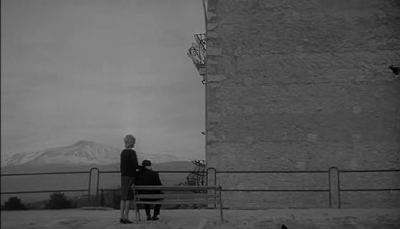
Antonioni’s treatment of women in these two films was undoubtedly avant-garde for the period of the late 1950’s and early 1960’s, offering an incomparable amount of admiration and respect for his female characters, unprecedented in other contemporary directors in correlation with the evolution of women’s roles in Italian society during a period of major social change. Sandro and Aldo are proven to be impotent when faced with these changes, both in relation to women and to the evolving Italian social landscape. We can sense in these masculine characters a kind of nostalgia and desire to live in the past while the “Antonionienne” woman feels the need to move forward into the future, even if it is uncertain and frightening. It is in these women that Antonioni perceives the courage and capacity to adapt to new social and emotional circumstances, which he cannot see in Sandro and Aldo.
While Antonioni ends L’Avventura on such an ambiguous note, he would continue his tetralogy with other similarly spirited women and somewhat less vague conclusions (excluding, obviously, L’Eclisse). In his three films following L’Avventura we can find more men who, like Aldo and Sandro, comport themselves with an aggressive and unhealthy sexuality (Giovanni in La Notte And Corrado in Il Deserto Rosso), who lack the perspicacity through which to appeal to the sentiments of others (Giovanni and Piero in L’Eclisse), and who are caught in a destructive egocentrism (Giovanni, Piero, and Corrado). Conversely, the women are presented in a totally different fashion in their quest for happiness and love; Antonioni paints them as beings possessing a sense of themselves and who listen to their own needs and desires, as well as of those who surround them. We can also suggest that, contrary to L’Avventura and Il Grido, these three films leave the spectator under the impression that these women have made the choice to leave their destructive and depraved companions and that their decisions were the right ones, no matter how painful. From the neorealist Il Grido to the more experimental Il Deserto Rosso, Antonioni introduced a rare breed of empowered, intelligent and sensible women who transcend the widespread representation of female characters in cinema of that era. This conception of femininity appears in many subtle ways, impacting the way he composed the frame or situated his characters – male and female – within their environment and alongside the décor, implicitly revealing his homage to the women of 1960’s Italy, the “Antonionienne” heroine.
Translated by Julie Ravary and Michael Bloom
Endnotes
1 Antonioni, Michelangelo. “A Talk with Michelangelo Antonioni”. Film Culture, No.24 1962, p.47
2 Chatman, Seymour. Antonioni: or, The Surface of the World. Berkeley: University of California Press, 1985, p.43
3 Priest, Stephen ed. Jean-Paul Sartre: Basic Writings. London and New York: Routledge, 2001, p.29
4 Totaro, Donato. “Salute Alida”. Offscreen. Vol.10, Issue 5, 31 May 2006, p.5
5 Arrowsmith, William. Antonioni, Poet of Images. New York: Oxford University Press, 1995, p.26
6 Antonioni, Michelangelo. “A Talk with Michelangelo Antonioni”. Film Culture, No.24 1962, p.51
7 Perrin, Claude. “L’Univers Fragmenté de L’Avventura” in Michelangelo Antonioni: L’Homme et L’Objet. Anthology by Michel Estève, Paris, France: edition Minard, 1964, p.119
8 Tailleur, Roger and Paul-Louis Thirard. Antonioni. Paris: Éditions Universitaire, 1963, p.95
9 One could also derive that Aldo’s fall from the tower in Il Grido could similarly be suggestive of his impotence as a man.
10 Schwarzer, Mitchell. “The Consuming Landscape: Architecture in the Films of Michelangelo Antonioni”. Ed. Mark Lamster. Architecture and Film. New York: Princeton Architectural Press, 2000, p.205


